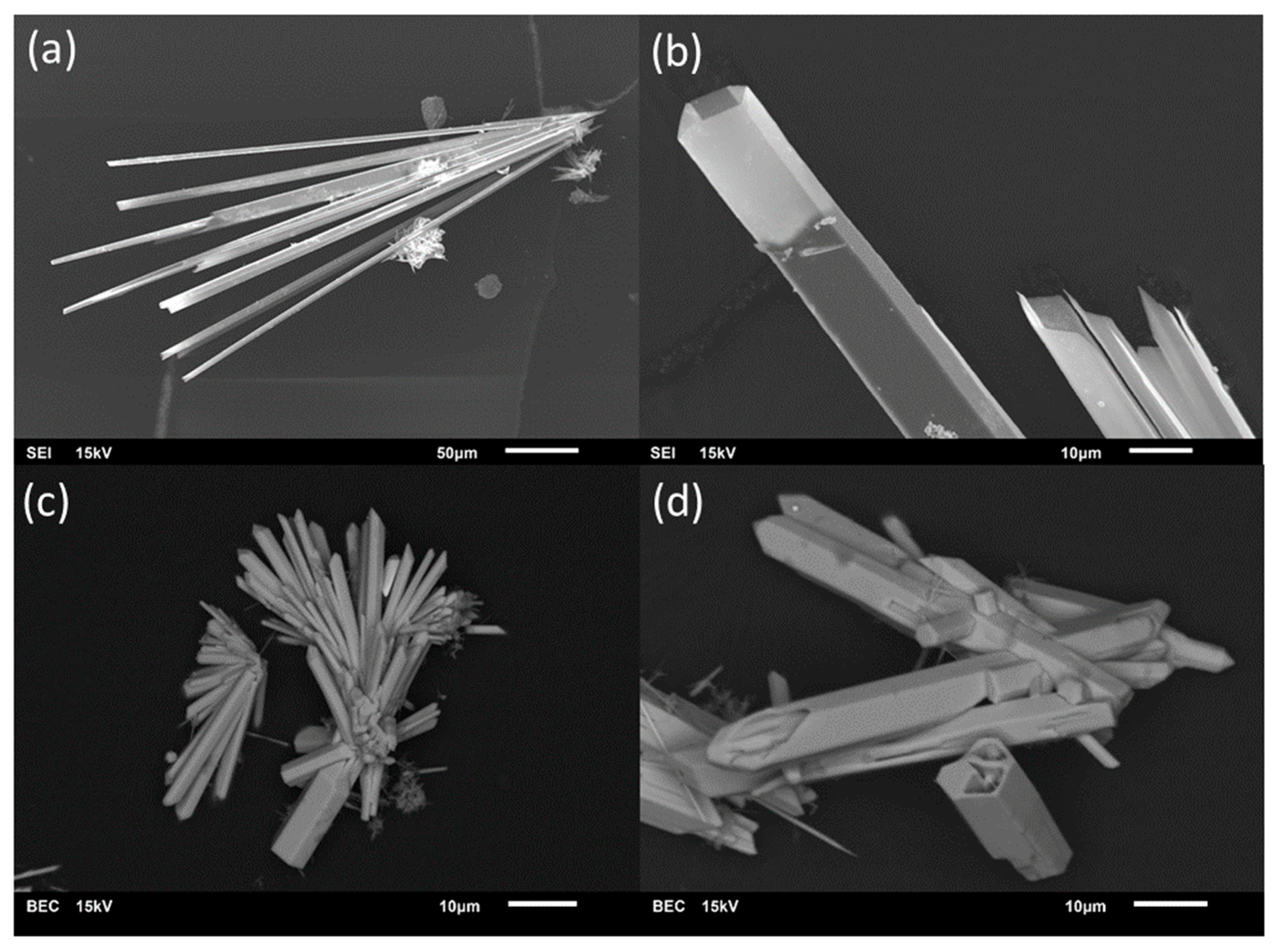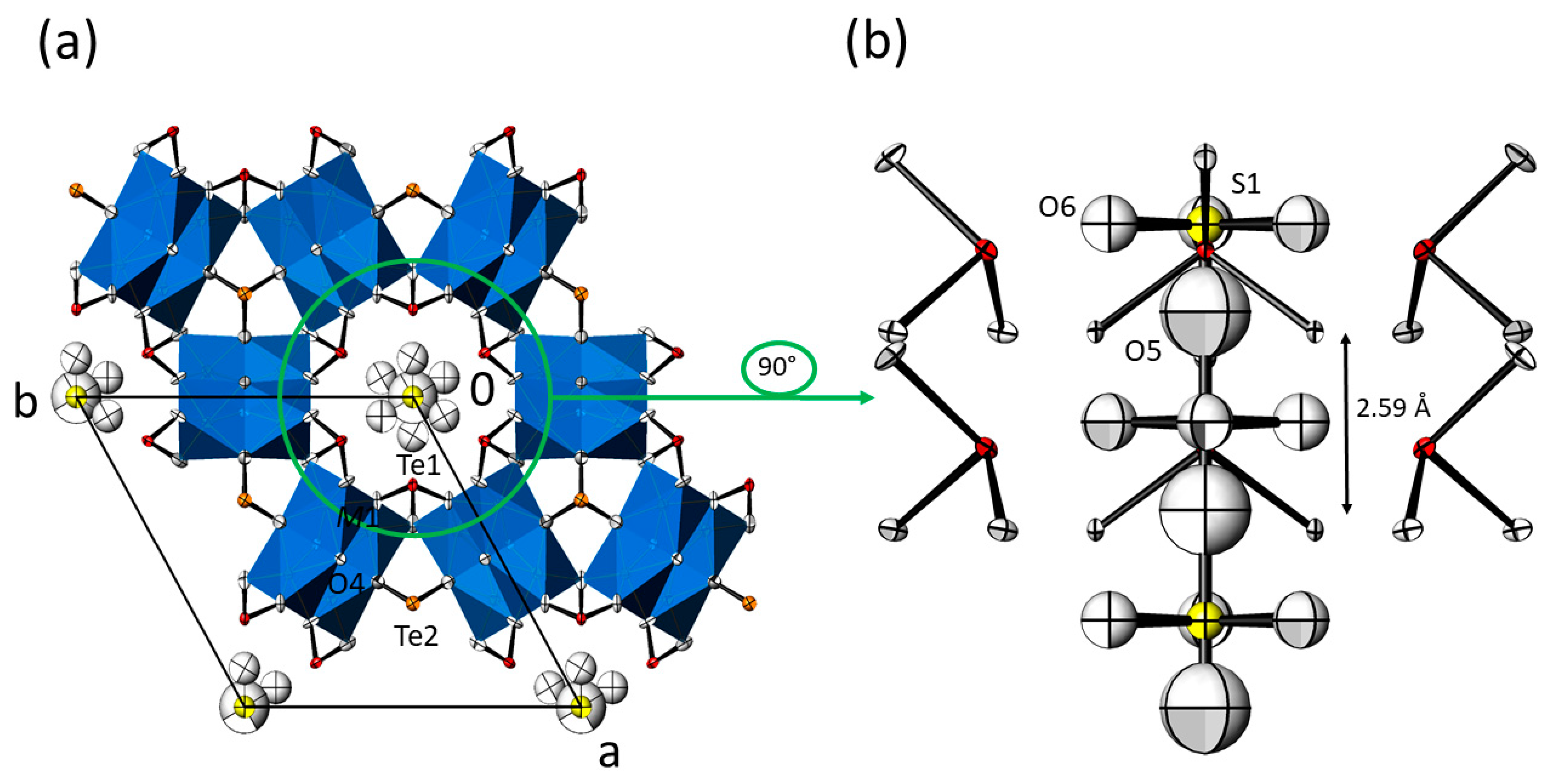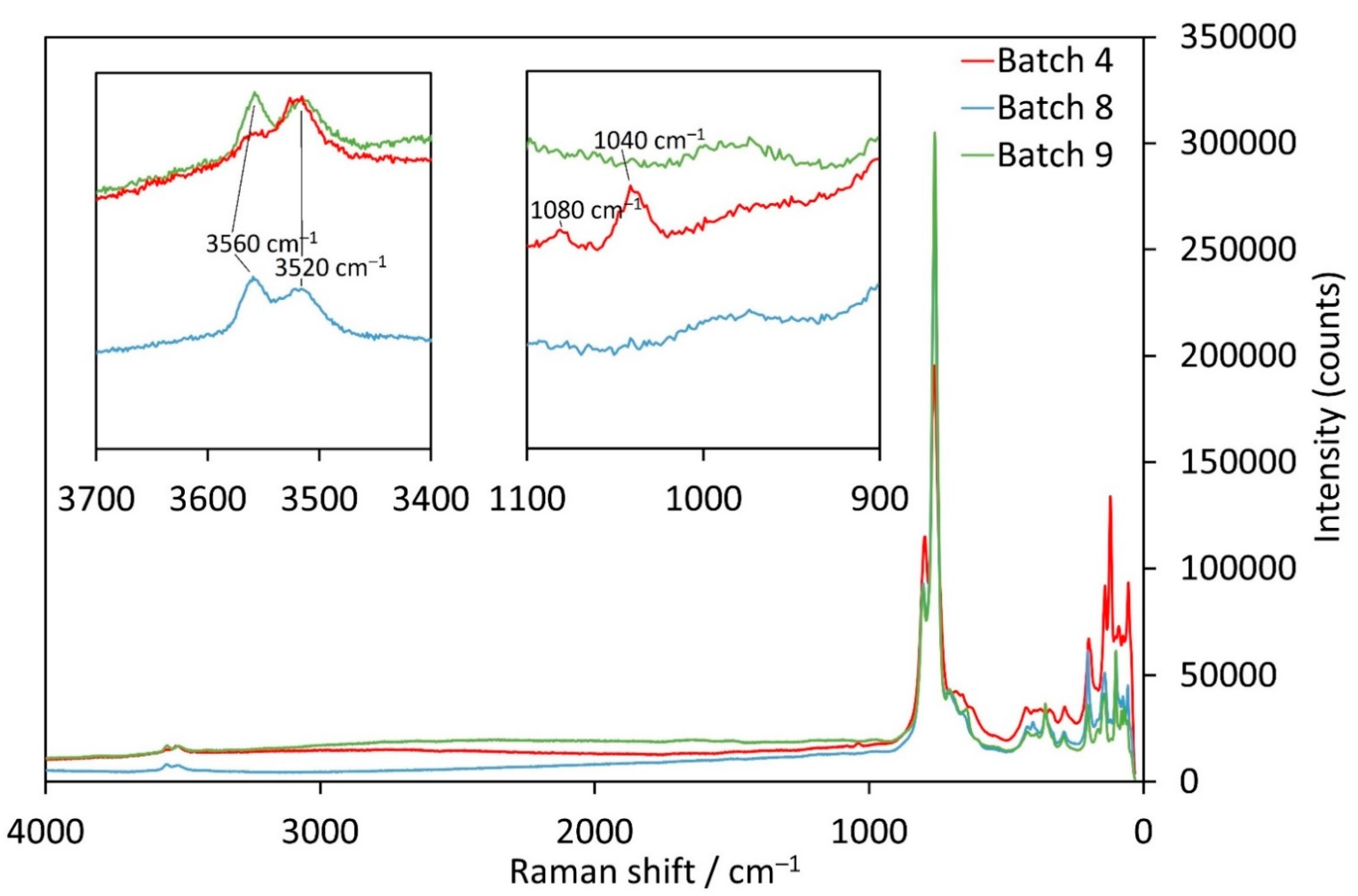The Family of MII3(TeIVO3)2(OH)2 (M = Mg, Mn, Co, Ni) Compounds—Prone to Inclusion of Foreign Components into Large Hexagonal Channels
Abstract
:1. Introduction
2. Materials and Methods
2.1. Synthesis
2.2. Diffraction Measurements and Crystal-Structure Refinements
2.3. Energy-Dispersive X-ray Spectrometry (EDS)
2.4. Raman Spectroscopy
3. Results and Discussion
3.1. Synthesis
3.2. Crystal Structures
3.3. EDS
3.4. Raman Spectroscopy
4. Conclusions
Supplementary Materials
Author Contributions
Funding
Data Availability Statement
Acknowledgments
Conflicts of Interest
References
- Ivanov, S.A.; Nordblad, P.; Mathieu, R.; Tellgren, R.; Ritter, C.; Golubko, N.V.; Politova, E.D.; Weil, M. New type of incommensurate magnetic ordering in Mn3TeO6. Mater. Res. Bull. 2011, 46, 1870–1877. [Google Scholar] [CrossRef]
- Ivanov, S.A.; Ritter, C.; Nordblad, P.; Tellgren, R.; Weil, M.; Carolus, V.; Lottermoser, T.; Fiebig, M.; Mathieu, R. New insights into the multiferroic properties of Mn3TeO6. J. Phys. D Appl. Phys. 2017, 50, 085001. [Google Scholar] [CrossRef]
- Arévalo-López, Á.M.; Solana-Madruga, E.; Aguilar-Maldonado, C.; Ritter, C.; Mentré, O.; Attfield, J.P. Magnetic frustration in the high-pressure Mn2MnTeO6 (Mn3TeO6-II) double perovskite. Chem. Commun. 2019, 55, 14470–14473. [Google Scholar] [CrossRef] [PubMed]
- Fruchart, D.; Montmory, M.C.; Bertaut, E.F.; Bernier, J.C. Structures magnétiques de Mn2TeO6 et V2WO6. Stabilité des modes magnétiques observés. J. Phys. 1980, 41, 141–147. [Google Scholar] [CrossRef]
- Matsubara, N.; Damay, F.; Vertruyen, B.; Barrier, N.; Lebedev, O.I.; Boullay, P.; Elkaim, E.; Manuel, P.; Khalyavin, D.D.; Martin, C. Mn2TeO6: A Distorted Inverse Trirutile Structure. Inorg. Chem. 2017, 56, 9742–9753. [Google Scholar] [CrossRef]
- Trömel, M.; Schmid, D. Tellurite des zweiwertigen Mangans, Kobalts und Nickels. Z. Anorg. Allg. Chem. 1972, 387, 230–240. [Google Scholar] [CrossRef]
- Trömel, M.; Scheller, T. Die Kristallstruktur von Co6Te5O16. Z. Anorg. Allg. Chem. 1976, 427, 229–234. [Google Scholar] [CrossRef]
- Miletich, R. Copper-substituted manganese-denningites, Mn(Mn1−xCux)(Te2O5)2 (0 ≤ x ≤ 1): Synthesis and crystal chemistry. Mineral. Petrol. 1993, 48, 129–145. [Google Scholar] [CrossRef]
- Cooper, M.A.; Hawthorne, F.C. The crystal structure of spiroffite. Can. Mineral. 1996, 34, 821–826. [Google Scholar]
- Irvine, J.T.S.; Johnston, M.G.; Harrison, W.T.A. Lone-pair containment in closed cavities. The MTe6O13 (M = Mn, Ni, Co) family of ternary oxides. Dalton Trans. 2003, 13, 2641–2645. [Google Scholar] [CrossRef]
- Feger, C.R.; Schimek, G.L.; Kolis, J.W. Hydrothermal synthesis and characterization of M2Te3O8 (M = Mn, Co, Ni, Cu, Zn): A series of compounds with the spiroffite structure. J. Solid State Chem. 1999, 143, 246–253. [Google Scholar] [CrossRef]
- Kohn, K.; Akimoto, S.-I.; Uesu, Y.; Asai, K. Crystal Structure and Magnetic Properties of MnTeO3, CoTeO3 and NiTeO3. J. Phys. Soc. Jpn. 1974, 37, 1169. [Google Scholar] [CrossRef]
- Kohn, K.; Inoue, K.; Horie, O.; Akimoto, S.-I. Crystal chemistry of MSeO3 and MTeO3 (M = Mg, Mn, Co, Ni, Cu, and Zn). J. Solid State Chem. 1976, 18, 27–37. [Google Scholar] [CrossRef]
- Eder, F.; Weil, M. Phase formation studies and crystal structure refinements in the MnII/TeIV/O/(H) system. Z. Anorg. Allg. Chem. 2022. [Google Scholar] [CrossRef]
- Ptáček, P. Substitutents and Dopants in the Structure of Apatite. In Apatites and Their Synthetic Analogues; IntechOpen: London, UK, 2016; pp. 289–334. [Google Scholar]
- Peacor, D.R.; Sarp, H.; Dunn, P.J.; Innes, J.; Nelen, J.A. Defernite from the Kombat mine, Namibia: A second occurrence, structure refinement, and crystal chemistry. Am. Mineral. 2006, 73, 888–893. [Google Scholar]
- Degen, T.; Sadki, M.; Bron, E.; König, U.; Nénert, G. The HighScore suite. Powder Diffr. 2014, 29, S13–S18. [Google Scholar] [CrossRef]
- APEX3 and SAINT; Bruker AXS Inc.: Madison, WI, USA, 2016.
- Krause, L.; Herbst-Irmer, R.; Sheldrick, G.M.; Stalke, D. Comparison of silver and molybdenum microfocus X-ray sources for single-crystal structure determination. J. Appl. Cryst. 2015, 48, 3–10. [Google Scholar] [CrossRef]
- Sheldrick, G.M. SHELXT–Integrated space-group and crystal-structure determination. Acta Crystallogr. 2015, 71, 3–8. [Google Scholar] [CrossRef]
- Sheldrick, G.M. Crystal structure refinement with SHELXL. Acta Crystallogr. 2015, 71, 3–8. [Google Scholar]
- ATOMS for Windows; Shape Software: Kingsport, TN, USA, 2006.
- Perez, G.; Lasserre, F.; Moret, J.; Maurin, M. Structure cristalline des hydroxytellurites de nickel et de cobalt. J. Solid State Chem. 1976, 17, 143–149. [Google Scholar] [CrossRef]
- Parsons, S.; Flack, H.D.; Wagner, T. Use of intensity quotients and differences in absolute structure refinement. Acta Crystallogr. 2013, 69, 249–259. [Google Scholar] [CrossRef] [PubMed]
- Flack, H.D. On enantiomorph-polarity estimation. Acta Crystallogr. 1983, 39, 876–881. [Google Scholar] [CrossRef]
- Wojdyr, M. Fityk: A general-purpose peak fitting program. J. Appl. Crystallogr. 2010, 43, 1126–1128. [Google Scholar] [CrossRef]
- Shirkhanlou, M.; Weil, M. The Mg member of the isotypic series MTe6O13. Acta Crystallogr. 2013, 69, i18. [Google Scholar]
- Poupon, M.; Barrier, N.; Pautrat, A.; Petit, S.; Perez, O.; Bazin, P. Investigation of Co6(OH)3(TeO3)4(OH)~0.9(H2O): Synthesis, crystal and magnetic structures, magnetic and dielectric properties. J. Solid State Chem. 2019, 270, 147–155. [Google Scholar] [CrossRef]
- Christy, A.G.; Mills, S.J.; Kampf, A.R. A review of the structural architecture of tellurium oxycompounds. Mineral. Mag. 2016, 80, 415–545. [Google Scholar] [CrossRef]
- Gagné, O.C.; Hawthorn, F.C. Bond-length distributions for ions bonded to oxygen: Alkali and alkaline-earth metals. Acta Crystallogr. 2016, 72, 602–625. [Google Scholar] [CrossRef]
- Gagné, O.C.; Hawthorn, F.C. Bond-length distributions for ions bonded to oxygen: Results for the transition metals and qu antification of the factors underlying bond-length variation in inorganic solids. IUCrJ 2020, 7, 581–629. [Google Scholar] [CrossRef]
- Shannon, R.D. Revised effective ionic radii and systematic studies of interatomic distances in halides and chalcogenides. Acta Crystallogr. 1976, 32, 751–767. [Google Scholar] [CrossRef]
- Gilli, G.; Gilli, P. The Nature of the Hydrogen Bond: Outline of a Comprehensive Hydrogen Bond Theory; Oxford University Press: New York, NY, USA, 2009. [Google Scholar]
- Galy, J.; Meunier, G.; Andersson, S.; Åström, A. Stéréochimie des eléments comportant des paires non liées: Ge(II), As(III), Se(IV), Br(V), Sn(II), Sb(III), Te(IV), I(V), Xe(VI), Tl(I), Pb(II), et Bi(III) (oxydes, fluorures et oxyfluorures). J. Solid State Chem. 1975, 13, 142–159. [Google Scholar] [CrossRef]
- Stöger, B.; Weil, M.; Silich, K.A.; Olenev, A.V.; Berdonosov, P.S.; Dolgikh, V.A. Synthesis and Structural Characterization of New Phases in the Cubic M3Te2O6X2 (M = Sr, Ba; X = Cl, Br) Structure Family. Z. Anorg. Allg. Chem. 2011, 637, 1322–1329. [Google Scholar] [CrossRef]
- Amoros, P.; Marcos, M.D.; Roca, M.; Beltran-Porter, A.; Beltran Porter, D. Synthetic Pathways for New Tubular Transition Metal Hydroxo and Fluoro-Selenites: Crystal Structures of M12(X)2(SeO3)8(OH)6 (M = Co2+, Ni2+; X = (OH)−). J. Solid State Chem. 1996, 126, 169–176. [Google Scholar] [CrossRef]
- Jenkins, H.D.B.; Thakur, K.P. Reappraisal of thermochemical radii for complex ions. J. Chem. Educ. 1979, 56, 576–577. [Google Scholar] [CrossRef]
- Nicholls, P. Introduction: The biology of the water molecule. CMLS Cell. Mol. Life Sci. 2000, 57, 987–992. [Google Scholar] [CrossRef] [PubMed]
- Weidlein, J.; Müller, U.; Dehnicke, K. Schwingungsfrequenzen I (Hauptgruppenelemente); Georg Thieme Verlag: Stuttgart, Germany, 1981. [Google Scholar]
- Farmer, V.C. (Ed.) Mineralogical Society Monograph 4: The Infrared Spectra of Minerals; The Mineralogical Society: London, UK, 1974. [Google Scholar]
- Frost, R.L.; Keeffe, E.C. Raman spectroscopic study of the tellurite minerals: Graemite CuTeO3·H2O and teineite CuTeO3·2H2O. J. Raman Spectrosc. 2009, 40, 128–132. [Google Scholar] [CrossRef]
- Frost, R.L.; Keeffe, E.C. Raman spectroscopic study of the tellurite mineral: Sonoraite Fe3+Te4+O3(OH)·H2O. J. Raman Spectrosc. 2009, 40, 133–136. [Google Scholar] [CrossRef]
- Rumsey, M.S.; Welch, M.D.; Mo, F.; Kleppe, A.K.; Spratt, J.; Kampf, A.R.; Raanes, M.P. Millsite CuTeO3·2H2O: A new polymorph of teineite from Gråurdfjellet, Oppdal kommune, Norway. Mineral. Mag. 2018, 82, 433–444. [Google Scholar] [CrossRef]







| Batch | Educts | Molar Ratios | Reaction Medium | Duration/d; Temperature/°C |
|---|---|---|---|---|
| 1 * | CoSO4·7H2O, TeO2, KOH | 3:2:9 | water | 7; 210 |
| 2 * | Co(NO3)2·6H2O, TeO2, KOH | 3:2:9 | water | 7; 210 |
| 3 * | MnCO3, TeO2, KOH | 1:1:4 | water | 7; 210 |
| 4 | MnCO3, TeO2, NaOH | 1:1:4 | water | 7; 210 |
| 5 * | MnSO4·H2O, TeO2, KOH, K2CO3 | 1:1:4:2 | water | 7; 210 |
| 6 | MnSO4·H2O, TeO2, KOH | 1:1:4 | water | 7; 210 |
| 7 * | MnSO4·H2O, TeO2, NaOH | 1:1:4 | water | 7; 210 |
| 8 * | MnCl2·4H2O, TeO2, NaOH | 1:1:4 | water | 7; 210 |
| 9 * | MnBr2, TeO2, NaOH | 1:1:4 | water | 7; 210 |
| 10 * | MnSO4·H2O, TeO2 | 3:1 | ammonia | 5; 210 |
| 11 * | NiSO4·6H2O, TeO2 | 3:1 | ammonia | 5; 210 |
| 12 * | CoSeO4·5H2O, TeO2 | 3:1 | ammonia | 5; 210 |
| 13 * | NiO, Fe(NO3)3·9H2O, Mg(OH)2, TeO2 | 1:1:1:1 | water | 68; 200 |
| Empirical Formula | H2Mn3O8Te2 | H1.70Mn3O8.30 S0.15Te2 | Br0.18H1.82Mn3 O7.82Te2 | H1.60Mg3O8.40 S0.20Te2 | Co3H1.64O8.36Se0.58 Te1.60 | H1.60Ni3O8.40S0.20Te2 |
|---|---|---|---|---|---|---|
| Structural Formula | Mn3(TeO3)2(OH)1.5{(OH)0.5} | Mn3(TeO3)2(OH)1.5{(SO4)0.15(OH)0.20} | Mn3(TeO3)2(OH)1.5{Br0.18(OH)0.32} | Mg3(TeO3)2(OH)1.5{(SO4)0.2(OH)0.1} | Co3(TeO3)1.6(SeO3)0.4-(OH)1.5{(SeO4)0.18(OH)0.14} | Ni3(TeO3)2(OH)1.5 {(SO4)0.2(OH)0.1} |
| Obtained from batch | 5 | 7 | 9 | 13 | 12 | 11 |
| Mr | 550.04 | 559.34 | 561.15 | 470.68 | 562.10 | 573.89 |
| Temp./°C | −173 | 23 | 23 | 23 | 25 | −173 |
| Cryst. dim./ mm3 | 0.09 × 0.04 × 0.03 | 0.11 × 0.02 × 0.02 | 0.12 × 0.02 × 0.02 | 0.30 × 0.01 × 0.01 | 0.09 × 0.01 × 0.01 | 0.05 × 0.01 × 0.01 |
| Cryst. colour | light-yellow | light-yellow | light-yellow | colourless | blue | yellow |
| Cryst. form | prism | prism | prism | prism | lath | lath |
| Space group, No. | P63mc, 186 | P63mc, 186 | P63mc, 186 | P63mc, 186 | P63mc, 186 | P63mc, 186 |
| Formula units Z | 4 | 4 | 4 | 4 | 4 | 4 |
| a/Å | 13.410(4) | 13.4509(4) | 13.4389(2) | 13.0705(15) | 13.0390(7) | 12.9703(7) |
| c/Å | 5.1393(17) | 5.1410(2) | 5.16780(10) | 5.0381(6) | 5.0199(4) | 4.9441(3) |
| V/Å3 | 800.3(6) | 805.53(6) | 808.28(3) | 745.39(19) | 739.12(10) | 720.31(9) |
| μ/mm−1 | 11.815 | 11.784 | 12.571 | 8.156 | 15.704 | 15.778 |
| X-ray density/g·cm−3 | 4.565 | 4.612 | 4.611 | 4.194 | 5.051 | 5.292 |
| θmin–θmax/° | 3.509–32.066 | 3.029–34.991 | 1.750–33.182 | 1.799–32.518 | 3.125–25.429 | 3.141–30.986 |
| h range | −20–20 | −20–21 | −16–19 | −19–19 | −14–15 | −17–18 |
| k range | −20–20 | −21–13 | −20–20 | −19–19 | −15–15 | −18–18 |
| l range | −7–7 | −8–8 | −7–7 | −7–7 | −6–6 | −7–7 |
| Measured refl. | 14,498 | 19,118 | 10,425 | 13,504 | 5006 | 6453 |
| Independent refl. | 1041 | 1300 | 1131 | 1006 | 516 | 858 |
| Observed refl. (I > 2σ(I)) | 992 | 1245 | 1059 | 856 | 455 | 794 |
| Rint | 0.0553 | 0.0443 | 0.0621 | 0.0978 | 0.0972 | 0.0809 |
| Tmin; Tmax | 0.5435; 0.7463 | 0.2816; 0.3604 | 0.5354; 0.7862 | 0.5652; 0.7464 | 0.4717; 0.7452 | 0.5554; 0.7462 |
| No. of parameters | 51 | 57 | 54 | 54 | 42 | 53 |
| Flack parameter [24,25] | 0.00(3) using 430 quotients | −0.01(2) using 547 quotients | −0.13(9) using 462 quotients | 0.02(4) using 344 quotients | 0.07(11) | 0.01(5) using 330 quotients |
| R1 (F2 > 2σ(F2)) | 0.0201 | 0.0149 | 0.0317 | 0.0364 | 0.0337 | 0.0328 |
| wR2(F2 all) | 0.0472 | 0.0351 | 0.0784 | 0.0855 | 0.0807 | 0.0707 |
| GOF | 1.118 | 1.044 | 1.072 | 1.066 | 1.055 | 1.059 |
| CSD-deposition code | 2,203,365 | 2,203,363 | 2,203,360 | 2,203,368 | 2,203,369 | 2,203,367 |
| Mn3(TeO3)2(OH)1.5(OH)0.5 | Mn3(TeO3)2(OH)1.5-{(SO4)0.15(OH)0.20} | Mn3(TeO3)2(OH)1.5-{Br0.18(OH)0.32} | |
| M1—O2 | 2.113(4) | 2.122(3) | 2.137(7) |
| M1—O1 | 2.119(3) | 2.137(2) | 2.142(5) |
| M1—O3 | 2.169(4) | 2.171(3) | 2.175(7) |
| M1—O2 | 2.201(4) | 2.217(2) | 2.227(6) |
| M1—O4 | 2.219(4) | 2.218(3) | 2.231(6) |
| M1—O4 | 2.347(4) | 2.339(3) | 2.333(6) |
| Te1—O2 (2×) | 1.877(4) | 1.874(2) | 1.871(6) |
| Te1—O1 | 1.910(5) | 1.883(4) | 1.898(9) |
| Te2—O3 (3×) | 1.854(6) | 1.852(4) | 1.851(9) |
| O4—H1 | 0.87(3) | 0.97(3) | 1.0(3) |
| H1—O4 · O3 | 3.111(10) | 3.124(9) | 3.122(11) |
| Mg3(TeO3)2(OH)1.5-{(SO4)0.2(OH)0.1} | Co3(TeO3)1.6(SeO3)0.4-(OH)1.5{(SeO4)0.18(OH)0.14} | Ni3(TeO3)2(OH)1.5-{(SO4)0.2(OH)0.1} | |
| M1—O2 | 2.031(8) | 2.035(11) | 2.014(8) |
| M1—O1 | 2.060(6) | 2.097(9) | 2.065(5) |
| M1—O3 | 2.049(9) | 2.097(11) | 2.040(8) |
| M1—O2 | 2.090(7) | 2.085(10) | 2.032(7) |
| M1—O4 | 2.130(9) | 2.157(12) | 2.124(7) |
| M1—O4 | 2.240(9) | 2.220(12) | 2.172(8) |
| Te1—O2 (2×) | 1.880(6) | 1.851(10) | 1.885(7) |
| Te1—O1 | 1.866(10) | 1.862(17) | 1.912(11) |
| Te2—O3 (3×) | 1.832(11) | 1.750(15) | 1.886(10) |
| O4—H1 | — | — | — |
| H1—O4 · O3 | — | — | — |
| Batch | M | Possible Inclusions | Measurement | T/°C | a/Å | c/Å | V/Å3 |
|---|---|---|---|---|---|---|---|
| 1 | Co | SO42−, OH− | powder | 25 | 13.1146(7) | 5.0475(3) | 751.8 |
| single-crystal | −173 | 13.1102(7) | 5.0179(4) | 746.9 | |||
| 1 * | powder | 25 | 13.1186(7) | 5.0335(3) | 750.2 | ||
| 2 | Co | NO3−, OH− | powder | 25 | 13.1126(7) | 5.0452(3) | 751.3 |
| single-crystal | −173 | 13.0907(4) | 5.02810(10) | 746.2 | |||
| 2 * | powder | 25 | 13.1127(8) | 5.0394(3) | 750.4 | ||
| 3 | Mn | CO32−, OH− | powder | 25 | 13.42771(15) | 5.16593(7) | 806.7 |
| single-crystal | −173 | 13.3999(4) | 5.1359(2) | 798.6 | |||
| 4 | Mn | CO32−, OH− | powder | 25 | 13.4171(3) | 5.16516(11) | 805.3 |
| 5 | Mn | SO42−, CO32−, OH− | powder | 25 | 13.4271(3) | 5.16877(10) | 807.0 |
| single-crystal | −173 | 13.4082(5) | 5.1371(3) | 799.8 | |||
| single-crystal | −173 | 13.410(4) | 5.1393(17) | 800.5 | |||
| 6 | Mn | SO42−, OH− | powder | 25 | 13.4779(2) | 5.16844(10) | 813.1 |
| 7 | Mn | SO42−, OH− | powder | 25 | 13.4902(5) | 5.1673(2) | 814.4 |
| single-crystal | −173 | 13.4216(7) | 5.1712(4) | 806.7 | |||
| 8 | Mn | Cl−, OH− | powder | 25 | 13.4206(2) | 5.17517(8) | 807.2 |
| single-crystal | 25 | 13.4364(4) | 5.1738(3) | 808.9 | |||
| 9 | Mn | Br−, OH− | powder | 25 | 13.4383(2) | 5.17202(8) | 808.9 |
| single-crystal | 25 | 13.4389(2) | 5.16780(10) | 808.3 | |||
| Co3(TeO3)2(OH)2 [23] | OH− | single-crystal | 25 | 13.034(6) | 5.016(3) | 738.0 | |
| Co3(TeO3)2(OH)2-·~0.45H2O [28] | OH−, H2O | single-crystal | 25 | 13.164(1) | 5.0321(6) | 755.2 | |
Publisher’s Note: MDPI stays neutral with regard to jurisdictional claims in published maps and institutional affiliations. |
© 2022 by the authors. Licensee MDPI, Basel, Switzerland. This article is an open access article distributed under the terms and conditions of the Creative Commons Attribution (CC BY) license (https://creativecommons.org/licenses/by/4.0/).
Share and Cite
Eder, F.; Weil, M.; Missen, O.P.; Kolitsch, U.; Libowitzky, E. The Family of MII3(TeIVO3)2(OH)2 (M = Mg, Mn, Co, Ni) Compounds—Prone to Inclusion of Foreign Components into Large Hexagonal Channels. Crystals 2022, 12, 1380. https://doi.org/10.3390/cryst12101380
Eder F, Weil M, Missen OP, Kolitsch U, Libowitzky E. The Family of MII3(TeIVO3)2(OH)2 (M = Mg, Mn, Co, Ni) Compounds—Prone to Inclusion of Foreign Components into Large Hexagonal Channels. Crystals. 2022; 12(10):1380. https://doi.org/10.3390/cryst12101380
Chicago/Turabian StyleEder, Felix, Matthias Weil, Owen P. Missen, Uwe Kolitsch, and Eugen Libowitzky. 2022. "The Family of MII3(TeIVO3)2(OH)2 (M = Mg, Mn, Co, Ni) Compounds—Prone to Inclusion of Foreign Components into Large Hexagonal Channels" Crystals 12, no. 10: 1380. https://doi.org/10.3390/cryst12101380






